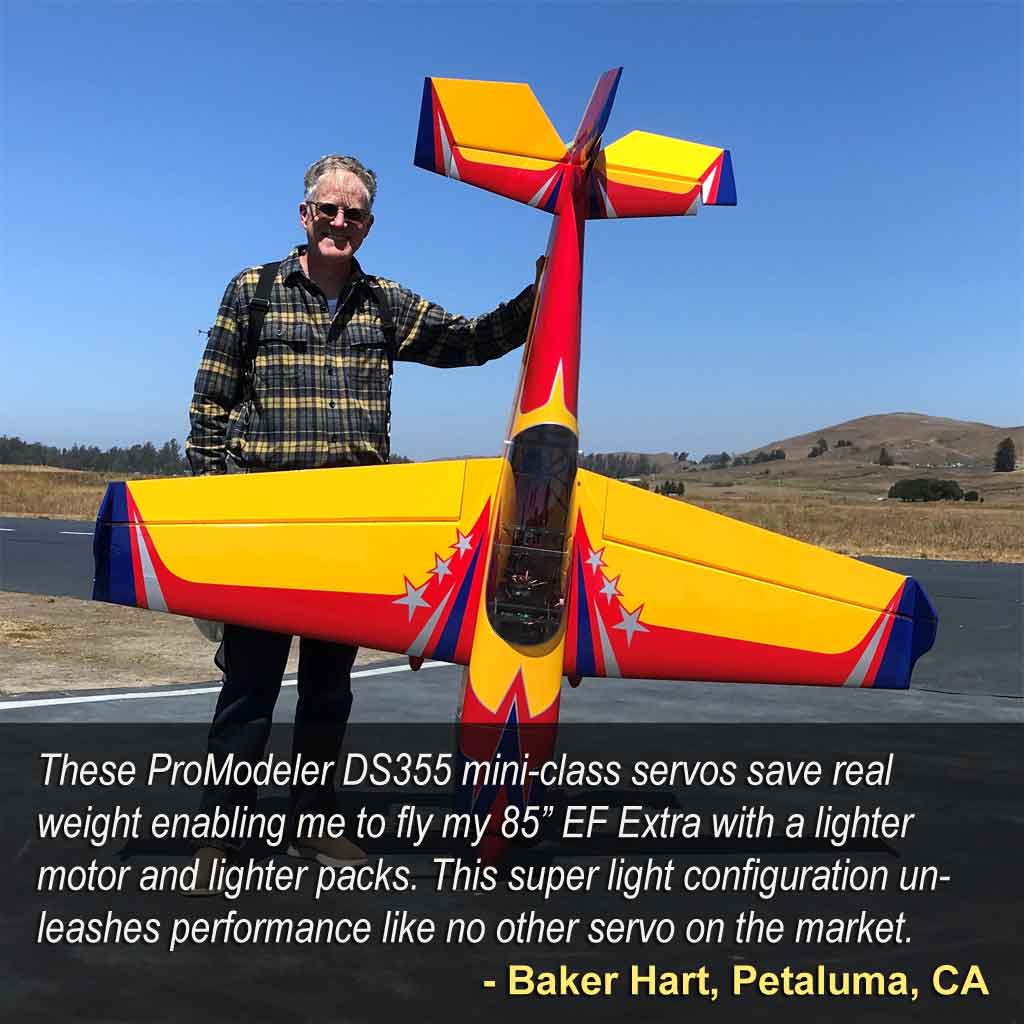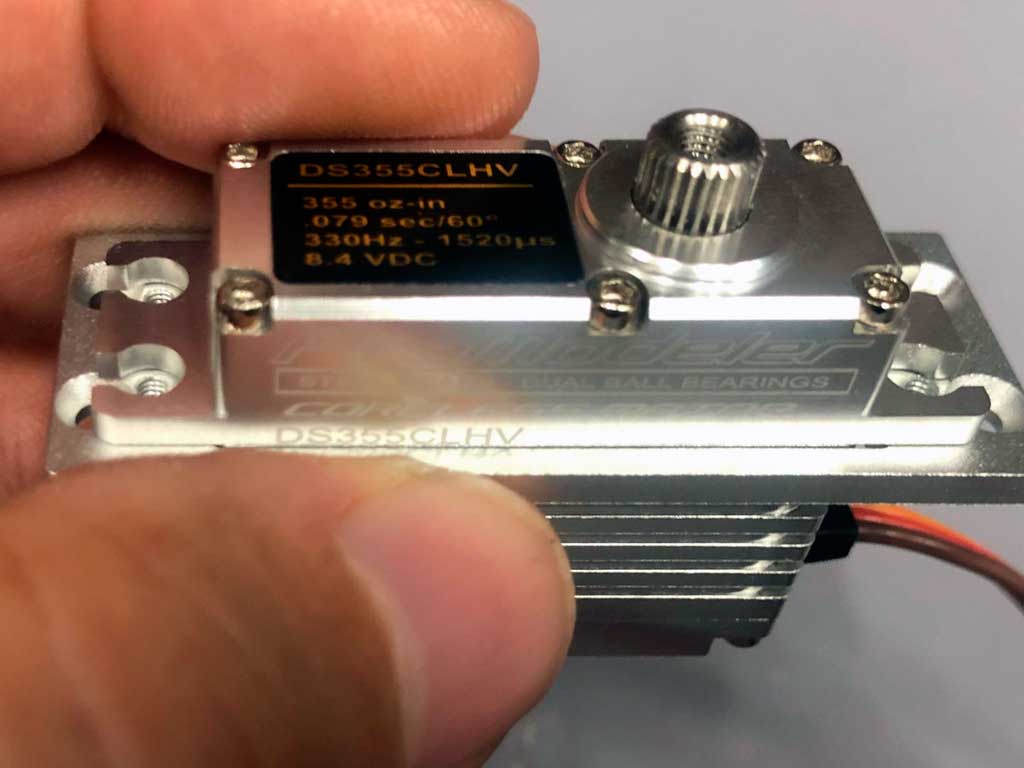Nobody needs a 400oz-in mini, are you guys crazy?
- Jonas Skorop, Philadelphia, PA

Yes, we'll admit to being a bit nuts - Jonas isn't the first to suggest it - though we've always taken it as a backhanded compliment. Anyway, let me explain why something like this +400oz-in mini-class servo exists.
It exists for one simple reason . . . a client threw money at us. A lot of money. For what purpose? Dunno, didn't ask (we never ask). Figure they want to tell us, they would (but they never do). And with certain customers, it's better this way, believe me. So because they wanted a lot of servos, we acted with alacrity to make it happen.
Fortunately, because we live within our vendor's motor catalogs (staying abreast of industry developments involving NIB-based miniature motors), we'd already been testing several. Meant we actually had the solution to their ask sussed out *before* they'd reached out! Why? Honestly? We we just seeking the limits of the DS205-case (upon which the DS355 and now this DS405 are based). Why? Research for research's sake because few modelers ask for more than our DS355CLHV delivers. We wanted to know what breaks so we could develop it further (and through 400oz-in, nothing breaks)
So yes, a few jet guys inquire (servos buried within full flying stabs with speeds into the low 200mph range so they always need more torque). Plus the ones who are eternally whinging for more oomph, fixed wing XA-pilots performing rifle rolls (+720°/sec is not fast enough, so they want more power to extend ever larger ailerons into the breeze in order to attain higher and higher rotation speed). So they're the exception, plus now, we have demand created by G&I customers!
So to the question, why does the DS405BLHV exists . . . money. Speaking of which, you've likely noted it's not exactly cheap. This can't be helped. Very sorry, but it is, what it is.

And as the above photo proves, a mini can find its way into larger models. Ones calling for standard size servos via M2S mount adapters. These are useful because there are quite a few modelers (mostly old timers) who grok the old saying, *grams add up to ounces*, and a mini weighs about 2/3 as much as an equivalent standard.
So old pros are always on the lookout for more torque within a smaller package. And in this regard, they're a lot like the G&I outfits (the ones designing unmanned vehicles). This little bit of 6061-T6 (all of 3g) comes in handy!


Anyway, orders involving large sums of money change everything. Since we based the DS355 off the DS205 (where it's like an Energizer Bunny because it lasts and lasts), we did the same for this one. So now the DS205, DS355, and DS405 - as alike as three peas in a pod (except for the motor) - offer alternatives. Which ones, those of you needing crazy performance *but* packaged in a mini-class case.
So built on a foundation that begins life as a solid billet of 6061-T6 aircraft aluminum, you're basically looking at the very best mini-size servo we know how to make. And it's a beast because of that huge hoss of a motor. This motor is what's letting this thing make stupid fast transit speeds and incredible power. And how it's built is the secret sauce that lets it last and last.
Bottom line? If your high performance 3D/XA model, jet, or heli needs it, this is the mini you want.

As simple as 1, 2, & 3
1. Start with the best possible brushless-motor. When commutation happens electronically (instead of mechanically), the motor runs cooler because there's no insulating build up of brush dust over time. And since electrons don't wear out, these lasts 5X longer than a brushed motor. Don't know diddly about servo motors? Learn more by reviewing this article: About RC Servo Motors where we take motors, cut them apart using a lathe and take photos of the guts to show you what makes them different.It's free!
2. Of course, if you want a stronger mini-size servo, it helps to start with a stronger motor. We also took a page out of our hotrodding hobby and like stuffing a big block where a small block lives in a Camaro, we used a big standard class motor in a mini-class case. Stuffing something like this into a mini-class case required thinking outside the box. Literally because the motor is so large it overhangs the case
3. The trick to shoehorning a large-frame motor into a mini-size frame is simple. It merely involves slotting the CNC-machined case and letting the monster motor hang out a little bit (which has a benefit of added cooling). Beginning with a solid billet of 6061-T6 aircraft aluminum, the end result is more than just pretty . . . it's bullet proof.
4. Then we use 10 Allen-head machine screws to secure the assembly instead of 4 (like our competitors) because once we ran the FEA (finite element analysis) within the CAD-computer we discovered this made the transmission assembly a lot more rigid. Of course, a more rigid assembly is the key to a gear train that better withstands abuse.
5. Dual dual ball bearings? You betcha! But instead of ABEC-3 bearings, we opted to use ABEC-9 because ultra high precision bearings offer better performance. Naturally, these cost more and we mention it because we're proud of what goes in our servo (and because we noticed our competitors don't publish bearing specs).
6. In this class of servo you're right to expect metal gears, but instead of COTS (commercial off the shelf) gears featuring brass/steel (plus fake titanium), we opted for pricey but much tougher custom steel/steel gears (with anodized aluminum 25T output shaft). Plus, our gears are wider (thicker) than usual because increasing the surface area means greatly increasing wear characteristics.
7. Optimized for high voltage (HV) battery packs because higher voltage means lower current (rated at 7.4V nominal, 8.4V max - but specs given at a realistic 7.4V instead of a voltage you'll only see when the pack is fresh off charge). As experienced modelers know, this becomes especially important when using servo extensions. Plus, a 2S LiPo pack weighs much less than an equivalent capacity NiCd, LiFe, or NiMH pack.
8. Since centering is the sine qua non for a high performance servo, we use MIL-SPEC components. Along with a genuine Nobel potentiometer, this means the best possible performance because we don't compromise in our goal of building the best mini-size servo money can buy.
9. If you believe protecting the electronics against vibration is important then you'll be happy to learn how instead of a cheapo piece of foam we protect the electronic components of the PCB (printed circuit board) against vibration with potting compound. This is exactly how the military and NASA bullet proof their electronics. And quite honestly, it's a pain in the hind quarters, but we think of it as going the extra mile because like you, we're modelers too. Or put another way, we fly what we sell.
Bottom line? The ProModeler Brushless SuperMini is the one you want because it's better. It's super precise, centers superbly, and is simply stronger than competing minis. This makes it ideal for cyclic duty on 500-class helicopters like a Goblin. Plus, it's compact enough for the slim wing of a super fast jet. Plus, it's über strong for 60" class freestyle electric acrobat. We don't hide what we put into it and we welcome comparison to any other mini-size servo on the planet Earth. Granted, others may offer you a similar looking mini, but for your money you'll get a less expensive motor, inferior gears, an assembly with fewer screws, cheaper bearings, and and they'll leave out little touches like the potting compound. Is it pricey? Yup! But as usual, you get what you pay for.

Note:
These are mini-size servos with very small gears and operating them manually via the servo horn may damage them. This damage is not covered by warranty. Please do not treat these like a standard size servos. You've been warned. Also, operating voltage is 4.8-8.4V, but optimal performance is obtained with a 2S LiPo instead of a BEC. This is because LiPos deliver the required current without voltage spikes, noise, or otherwise adversely affecting the delicate avionics (15C or better is recommended). After all, synthetic orange colored Tang may have gone to the moon, but it doesn't compare to freshly squeezed orange juice. Same thing when it comes to feeding your avionics!